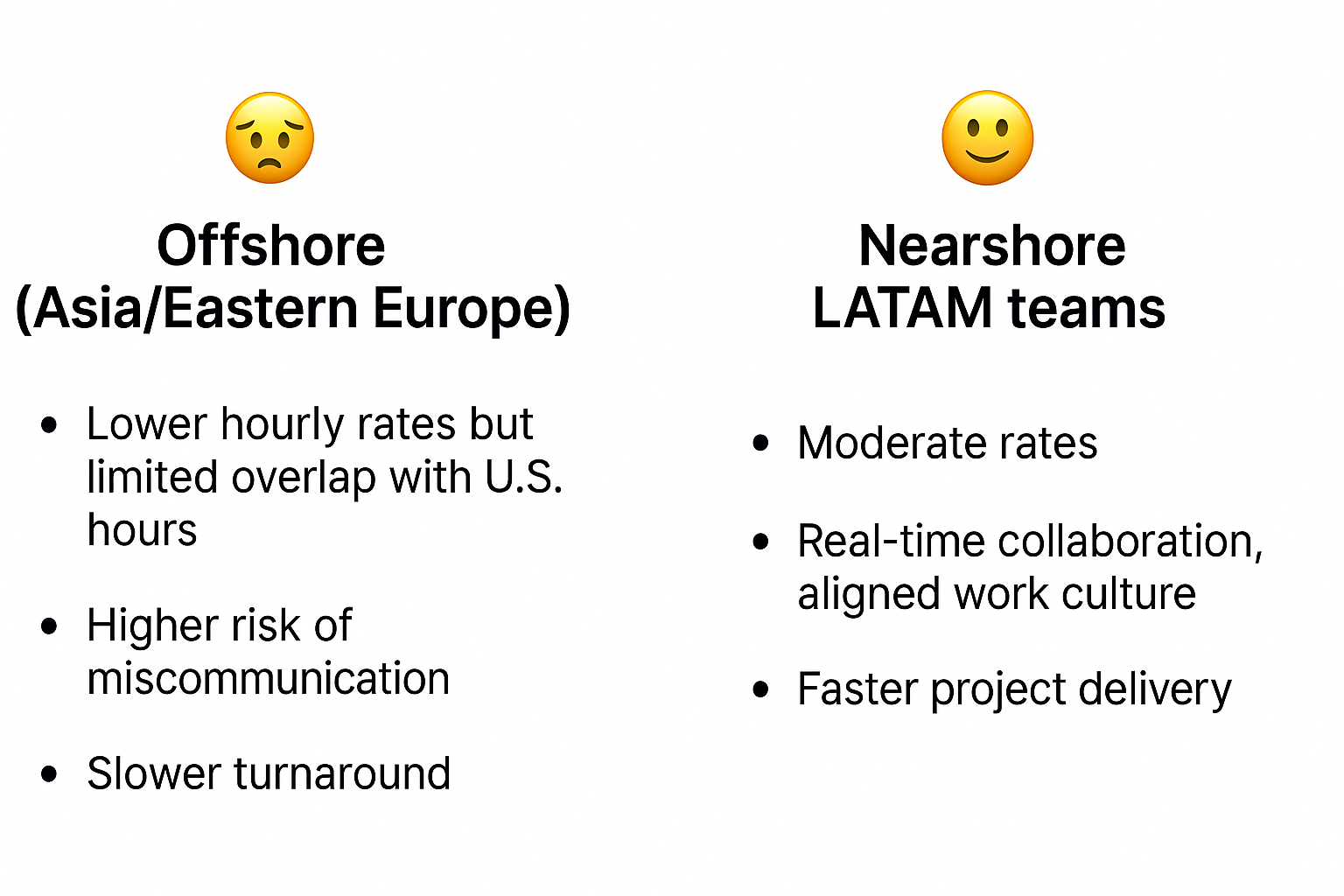Join our newsletter



The demand for software engineers in the U.S. continues to outpace supply:
According to the U.S. Bureau of Labor Statistics, jobs for software developers, QA analysts, and testers are projected to grow by 17% between 2023 and 2033, much faster than the average for all occupations.
Every year, there will be around 140,100 job openings in these fields due to growth and replacement needs.
In June 2025, there were approximately 7.4 million open jobs in the U.S., showing high labor mobility and constant pressure on companies to fill roles.
This means that waiting to fill local positions can be costly in both time and money. That’s why many companies are exploring outsourcing to LATAM developers or directly choosing to hire developers in Latin America to mitigate those risks.

LATAM teams work in overlapping hours with U.S. teams, allowing real-time collaboration, sprint reviews, and faster bug resolution.
Most developers in Mexico, Colombia, and Argentina have functional English proficiency that allows them to document, raise blockers, and participate in meetings effectively—without needing “perfect English.”
A CloudDevs study estimates the cost of hiring LATAM developers at $45–55/hour, significantly lower than U.S. rates.
Another analysis shows that hiring a web developer in the U.S. costs around $94,000/year, while nearshoring to LATAM reduces that to about $30,000, saving nearly $64,000 per role.
A Forbes article also reports cost savings of up to 50% for companies outsourcing to LATAM.
Cultural proximity and communication styles make integration smoother than with offshore teams in Asia or Eastern Europe.
Universities and bootcamps in the region are producing thousands of professionals skilled in React, Node.js, Python, DevOps, and QA. Many remote developers from LATAM are ready to join agile teams immediately.
Another model gaining traction is staff augmentation in Latin America. Instead of handing off projects entirely, companies integrate vetted mid-senior developers directly into their squads. This approach reduces onboarding time, accelerates delivery, and ensures accountability.
With tools like onboarding process automation, companies can bring a developer online in less than 48 hours. Automated flows for contracts, credentials, and setup remove the bottlenecks that typically slow down outsourcing. In fact, some companies report a 70% reduction in onboarding time when combining automation tools with LATAM staff augmentation.
A U.S.-based SaaS company decided to hire developers in Latin America to accelerate its roadmap. Within just a few weeks, they assembled a blended team of React, Python, and QA engineers from Colombia and Argentina.
This example shows how outsourcing to LATAM developers not only lowers costs but also speeds up delivery and enhances quality.
LATAM talent is ideal if:
| Aspect | Offshore (Asia / Eastern Europe) | Nearshore LATAM |
|---|---|---|
| Hourly Rates | Lower upfront, but often rise with coordination and delays | Moderate, with better ROI and fewer hidden costs |
| Time Zone | Significant differences, little overlap | Strong overlap with U.S. hours |
| Communication & Culture | Risk of cultural and linguistic friction | Smooth alignment with U.S. teams |
| Delivery Speed | Delays due to time zones and misalignment | Faster delivery cycles with real-time feedback |

The Auxis 2024 Report highlights that demand for outsourcing in LATAM is growing, with a focus on efficiency and productivity.
Trends include AI and automation, customer support bots, data pipelines, and onboarding workflow automation. For example, support bots on WhatsApp are being developed by LATAM teams for global companies, showcasing not just coding ability but also innovation capacity.
Continued investment in digital infrastructure and technical education strengthens LATAM’s competitive edge.
The global tech talent shortage isn’t slowing down. But the solution is closer than many think. Companies that choose to hire developers in Latin America gain access to skilled, cost-efficient, and culturally aligned professionals.
With functional English, high-context communication, and an ownership mindset, LATAM developers are not just filling roles—they are driving innovation and growth. For U.S. companies seeking real scalability, the smartest move is clear: look south.
Ready to explore? Let’s build your nearshore team today.